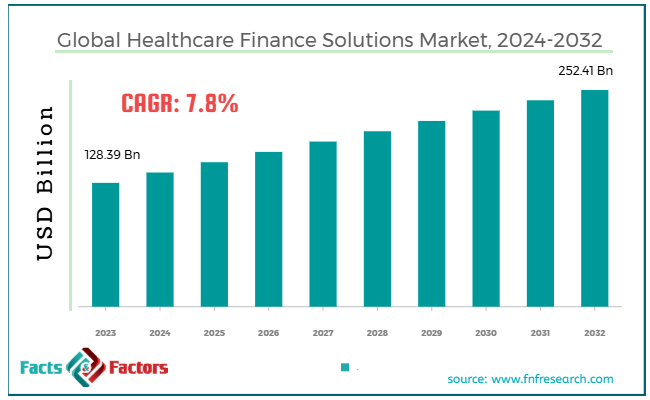Search Market Research Report
Healthcare Finance Solutions Market Size, Share Global Analysis Report, 2024 – 2032

Healthcare Finance Solutions Market Size, Share, Growth Analysis Report By Equipment Type (Diagnostic/Imaging Equipment, Specialist Beds, Surgical Instruments, Decontamination Equipment, IT Equipment), By Healthcare Facility Type (Hospitals & Health Systems, Outpatient Imaging Centers, Outpatient Surgery Centers, Physician Practices & Outpatient Clinics, Diagnostic Laboratories, Urgent Care Clinics, Skilled Nursing Facilities, Pharmacies, and Others), By Service (Equipment And Technology Finance, Working Capital Finance, Project Finance Solutions, Corporate Lending), And By Region - Global Industry Insights, Overview, Comprehensive Analysis, Trends, Statistical Research, Market Intelligence, Historical Data and Forecast 2024 – 2032
Industry Insights
[226+ Pages Report] According to Facts & Factors, the global healthcare finance solutions market size was worth around USD 128.39 billion in 2023 and is predicted to grow to around USD 252.41 billion by 2032, with a compound annual growth rate (CAGR) of roughly 7.8% between 2024 and 2032.

 Market Overview
Market Overview
Healthcare finance solutions are finance-related strategies and services dedicated to satisfying certain demands of healthcare businesses. They comprise funding options for clinics, hospitals, and several healthcare providers to better manage their operational costs, capital projects, expenses, and growth. The global healthcare finance solutions market is predicted to experience momentous growth on the back of increasing healthcare costs, a growing senior population, and improvements in healthcare.
The rising costs of medical treatments and services are triggering healthcare businesses to opt for financing services to effectively manage expenditures. The senior population mostly demands regular chronic disease management, frequent medical operations, and long-term care, thus causing high healthcare expenditure. This fueling demand supports the need for suitable healthcare finance solutions and funding.
Furthermore, healthcare finance services offer essential funding for medical facilities and hospitals to promote their infrastructure and adopt novel technologies like telemedicine, AI, and robotic surgeries to enhance patient care.
Nonetheless, the global market is adversely impacted by factors like complex regulatory scenarios and increasing debt levels. The healthcare market is seriously regulated, and navigating these regulations may be challenging for finance providers. Compliance with several reimbursement policies may increase costs for providers and hamper the industry's growth.
Moreover, high debt levels, mainly in hospitals, may result in a reluctance to opt for loans and other finance products owing to issues with the potential for repayment.
Yet, the global market will witness substantial growth owing to the development of healthcare infrastructure and inclination towards value-based care. Growing urbanization and emphasis on healthcare accessibility is an opportunity for financing services to cater to diverse groups in developing economies.
Also, the inclination towards value-based care is transforming the way healthcare businesses are refunded. This opens avenues for healthcare finance solutions that aid providers navigate novel payment models, enhancing outcomes, and optimizing operations.
 Key Insights:
Key Insights:
- As per the analysis shared by our research analyst, the global healthcare finance solutions market is estimated to grow annually at a CAGR of around 7.8% over the forecast period (2024-2032)
- In terms of revenue, the global healthcare finance solutions market size was valued at around USD 128.39 billion in 2023 and is projected to reach USD 252.41 billion by 2032.
- The healthcare finance solutions market is projected to grow significantly owing to supportive government healthcare initiatives and programs, a rising number of healthcare startups, and the speedy adoption of innovative technologies like robotic surgeries, artificial intelligence, and telemedicine.
- Based on equipment type, the diagnostic/imaging equipment segment is expected to lead the market, while the IT equipment segment is expected to register considerable growth.
- Based on healthcare facility type, the hospitals & health systems segment is the dominating segment among others, while the physician practices & outpatient clinics segment is projected to witness sizeable revenue over the forecast period.
- Based on service, the equipment and technology finance segment is expected to lead the market as compared to the working capital finance segment.
- Based on region, North America is projected to dominate the global market during the estimated period, followed by Asia Pacific.
 Growth Drivers
Growth Drivers
- Inclination towards value-based care significantly impacts the healthcare finance solutions market growth
The inclination towards a value-based care model from a fee-for-fee service model is basically transforming how medical providers are reimbursed. Value-based emphasizes patient outcomes instead of just quantity of service, resulting in novel financial models that need modernized finance solutions.
By 2025, nearly 70% of healthcare providers in the United States are predicted to shift towards value-based care. This majorly marks an inclination towards reimbursement models.
According to reports, the United States healthcare financial solutions will experience remarkable adoption owing to the inclination for VBC (Value-Based Care). Providers are looking for financial help to spend on technologies and infrastructure needed to shift to value-based models.
- The growing number of government healthcare programs fuels the market growth
Government initiatives and programs like Medicaid and Medicare offer a notable section of healthcare funding in diverse nations. Since these programs are gaining prominence on a global scale, healthcare providers are facing barriers to navigating complex reimbursement series. This fuels the demand for effective finance solutions.
In 2023, in the United States, Medicaid and Medicare shared nearly 40% of the economy’s population, and overall government expenses surpassed USD 1 trillion.
Also, cybersecurity breaches in medical rose by approximately 81% from 2023-24, highlighting the rising complexity of managing medical and financial data in a well-regulated environment.
In 2024, Modern Healthcare stated that the growing cybersecurity concerns, along with the rising government reimbursement, need healthcare providers to spend on both IT and financial solutions. This will help to manage reimbursements, claims, and compliance effectively.
 Restraints
Restraints
- Restricted financing access for small providers adversely impacts the progress of the healthcare finance solutions market
Small and self-governing healthcare providers, mainly those in underserved and rural areas, are witnessing issues regarding accessibility to healthcare finance solutions. They are mostly facing challenges with funding or securing loans owing to supposed higher risks, lack of collateral, and restricted financial infrastructure. This might significantly hamper the technological upgrades and growth of the global healthcare finance solutions market.
In the United States, small healthcare practices witnessed a 22% failure in rates of loan approval in 2024.
Furthermore, NRHA or the National Rural Health Association stated that rural healthcare providers are witnessing substantial challenges in accessing healthcare finance solutions. NRHA also underlined that community hospitals are particularly at risk since funding for such institutions is restricted because of credit constriction from financial institutions.
 Opportunities
Opportunities
- Green Healthcare financing to positively affect the healthcare finance solutions market growth
As environment sustainability is a key focus in the medical sector, the demand for green healthcare financing solutions is also rising. Healthcare businesses are actively looking for financial solutions to adopt energy-effective practices, waste reduction, eco-friendly technologies, and renewable energy systems. This industry is still in its promising stage, offering an exceptional opportunity for development.
The Healthcare Facilities Today (2024) announced that healthcare institutions are actively emphasizing “green building” certifications like LEED (Leadership in Energy and Environmental Design). These institutions are seeking financing options to spend in environmentally-friendly prospects for ecological healthcare finance solutions.
 Challenges
Challenges
- Integration of modern and traditional healthcare finance solutions restricts the growth of the healthcare finance solutions market
Healthcare businesses frequently face challenges with the integration of conventional finance systems with improved digital solutions. Legacy financial systems, though dependable, do not always support the novel demands of healthcare providers like financial tracking in real-time, integration with different health management systems, and AI-based decision-making. The complexity of upgrading such systems without compromising financial stability is noteworthy.
According to a survey in 2023, approximately 65% of healthcare providers confessed that their older financial systems do not comply with the needs of regulatory changes and novel technologies, thus hampering their ability to simplify financial operations. The worldwide healthcare financial management software industry is projected to reach USD 22 billion and progress by 9.5% CAGR by 2030. This will be fueled by the growing need to enhance and integrate finance systems.
 Report Scope
Report Scope
Report Attribute |
Details |
Market Size in 2023 |
USD 128.39 Billion |
Projected Market Size in 2032 |
USD 252.41 Billion |
CAGR Growth Rate |
7.8% CAGR |
Base Year |
2023 |
Forecast Years |
2024-2032 |
Key Market Players |
Cerner Corporation, McKesson Corporation, GE Healthcare, Siemens Healthineers, Philips Healthcare, Medtronic, CitiHealth, Healthcare Financial Services (HFS), HCA Healthcare, Fitch Solutions, Trinity Health, Baxter Healthcare, Optum, Sun Life Financial, MedAssets, and Others. |
Key Segment |
By Equipment Type, By Healthcare Facility Type, By Service, and By Region |
Major Regions Covered |
North America, Europe, Asia Pacific, Latin America, and the Middle East &, Africa |
Purchase Options |
Request customized purchase options to meet your research needs. Explore purchase options |
 Segmentation Analysis
Segmentation Analysis
The global healthcare finance solutions market is segmented based on equipment type, healthcare facility type, service, and region.
Based on equipment type, the global healthcare finance solutions industry is divided into diagnostic/imaging equipment, specialist beds, surgical instruments, decontamination equipment, and IT equipment. In 2023, the diagnostic/imaging equipment segment registered a notable share of the market owing to its growing prominence and continuous progress and its importance in medical diagnosis. Imaging technology has experienced substantial growth because of its progress and modernization like AI-enabled imaging software that improves diagnostic precision. Diagnostic equipment is vital in emergency care and routine healthcare settings. Segmental growth is also fueled by the rising need for enhanced diagnostic capabilities, mainly in diagnostic centers, hospitals, and specialty clinics. These machineries are crucial for treatment planning and early diagnosis, which boosts their significance in the medical sector.
Based on healthcare facility type, the global healthcare finance solutions industry is segmented as hospitals & health systems, outpatient imaging centers, outpatient surgery centers, physician practices & outpatient clinics, diagnostic laboratories, urgent care clinics, skilled nursing facilities, pharmacies, and others. The hospitals & health systems segment will progress at a considerable CAGR over the estimated period since hospitals are actively investing in enhanced medical systems and digital health solutions and widening their service offering. The rising demand for VBC and the inclination towards patient-involved models in hospitals need high capital investments.
Also, with the rising healthcare services costs, medical technologies, and pharmaceuticals, the health systems and hospitals face financial burdens. They are mostly dependent on financial solutions to effectively manage costs, maintain operations, and expand services.
Based on service, the global healthcare finance solutions market is segmented as equipment and technology finance, working capital finance, project finance solutions, and corporate lending. The equipment and technology finance segment is projected to lead the market in the future owing to its greater significance.
Healthcare providers require major funding for buying, upgrading, or leasing of IT systems and medical equipment like EHR, diagnostic imaging tools, telemedicine technology, and surgical instruments. With the speedy growth of technological advancements in the healthcare sector, financing solutions are important for allowing providers to maintain a competitive edge.
 Regional Analysis
Regional Analysis
- North America to witness significant growth over the forecast period
North America registered a considerable share of the global healthcare finance solutions market in 2023 and is projected to continue dominance over the forecast years as well. The growth is attributed to the improved healthcare infrastructure, technological adoption, and supportive regulatory environment. North America brags about its well-developed infrastructure, including cutting-edge medical facilities, improved diagnostic tools, and quality technologies.
The rising need for constant investment in diverse technologies and equipment and the growth of healthcare services is majorly fueling the demand for the said solutions. The region leads in the adoption of enhanced healthcare technologies like AI-based diagnostics, telemedicine, and EHR. Such technologies increase the need for better financing solutions.
Furthermore, key economies like the U.S. hold supportive regulatory environments for healthcare finance, offering suitable and clear guidelines for healthcare businesses to access financing solutions and funding.
Asia Pacific is the second-leading region in the global healthcare finance solutions industry, owing to the rising healthcare demand and expansion of medical infrastructure. The region is experiencing elevated demand for healthcare needs fueled by the growing aging and large population.
Economies like India and China are seeing increasing demand due to increased life expectancy, urbanization, and the growth of chronic disorders. This majorly fuels the need for high investment in medical services and infrastructure.
Several economies are also actively investing in better infrastructure, comprising diagnostic centers, medical facilities, and hospitals. This creates demand for financing solutions to aid such large-scale growth and development.
 Competitive Analysis
Competitive Analysis
The global healthcare finance solutions market is led by players like:
- Cerner Corporation
- McKesson Corporation
- GE Healthcare
- Siemens Healthineers
- Philips Healthcare
- Medtronic
- CitiHealth
- Healthcare Financial Services (HFS)
- HCA Healthcare
- Fitch Solutions
- Trinity Health
- Baxter Healthcare
- Optum
- Sun Life Financial
- MedAssets
 Key Market Trends
Key Market Trends
- Inclination towards value-based care financing:
Healthcare providers are actively using value-based care models that emphasize patient outcomes instead of volumes of services offered. This inclination is notably impacting healthcare finance solutions as businesses require financial models that comply with novel payment structures.
- Growth in digital health financing:
The speedy adoption of digital health solutions like AI-based diagnostics, telemedicine, and EHR is fueling the demand for specialized financing solutions. Providers are opting for financial support to spend on these technologies. This will result in a rise in financing for healthcare IT software, infrastructure, and digital transformation projects.
The global healthcare finance solutions market is segmented as follows:
 By Equipment Type Segment Analysis
By Equipment Type Segment Analysis
- Diagnostic/Imaging Equipment
- Specialist Beds
- Surgical Instruments
- Decontamination Equipment
- IT Equipment
 By Healthcare Facility Type Segment Analysis
By Healthcare Facility Type Segment Analysis
- Hospitals & Health Systems
- Outpatient Imaging Centers
- Outpatient Surgery Centers
- Physician Practices & Outpatient Clinics
- Diagnostic Laboratories
- Urgent Care Clinics
- Skilled Nursing Facilities
- Pharmacies
- Others
 By Service Segment Analysis
By Service Segment Analysis
- Equipment and Technology Finance
- Working Capital Finance
- Project Finance Solutions
- Corporate Lending
 By Regional Segment Analysis
By Regional Segment Analysis
- North America
- The U.S.
- Canada
- Mexico
- Europe
- France
- The UK
- Spain
- Germany
- Italy
- Rest of Europe
- Asia Pacific
- China
- Japan
- India
- Australia
- Southeast Asia
- Rest of Asia Pacific
- The Middle East & Africa
- Saudi Arabia
- UAE
- Egypt
- Kuwait
- South Africa
- Rest of the Middle East & Africa
- Latin America
- Brazil
- Argentina
- Rest of Latin America
Table of Content
Industry Major Market Players
- Cerner Corporation
- McKesson Corporation
- GE Healthcare
- Siemens Healthineers
- Philips Healthcare
- Medtronic
- CitiHealth
- Healthcare Financial Services (HFS)
- HCA Healthcare
- Fitch Solutions
- Trinity Health
- Baxter Healthcare
- Optum
- Sun Life Financial
- MedAssets

Copyright © 2024 - 2025, All Rights Reserved, Facts and Factors


